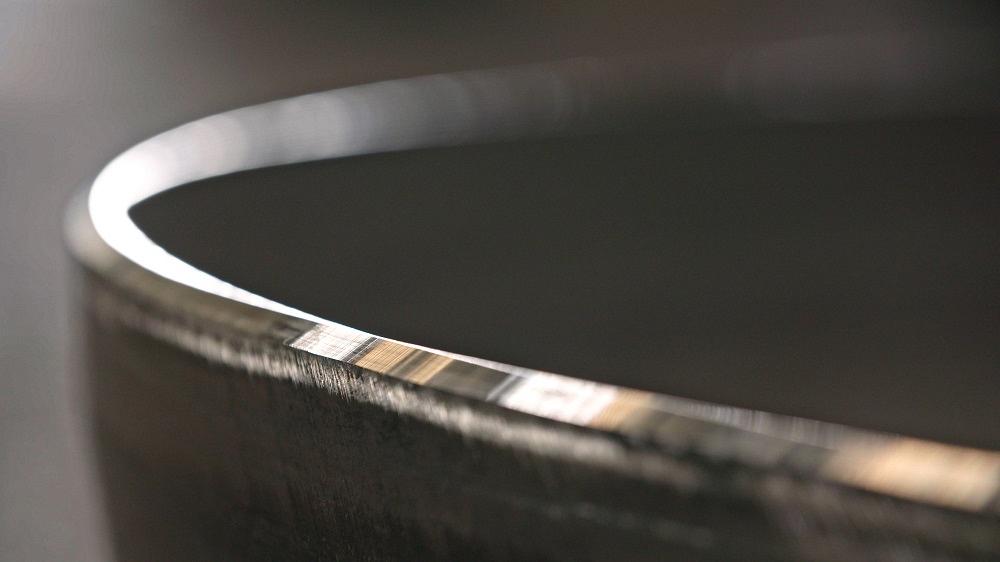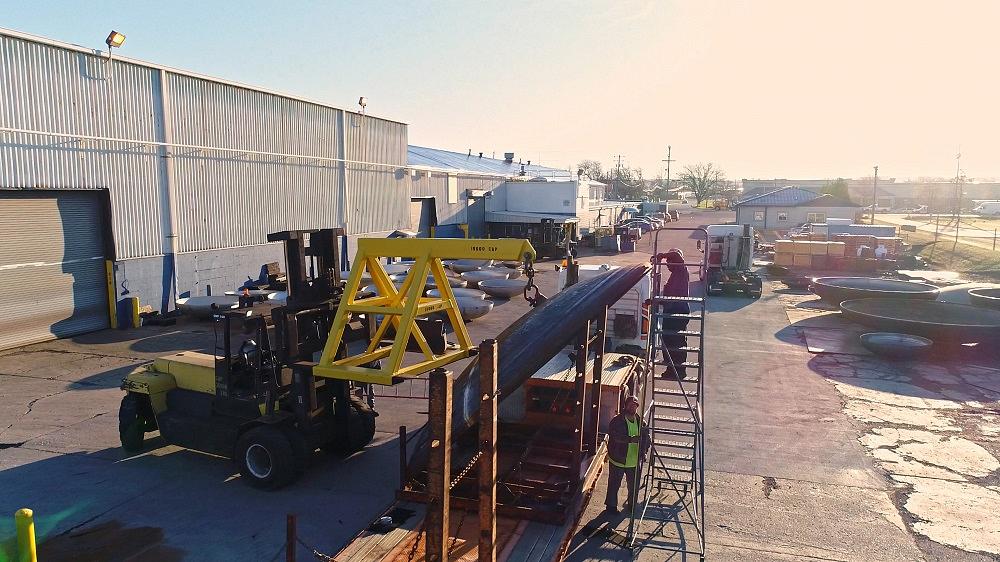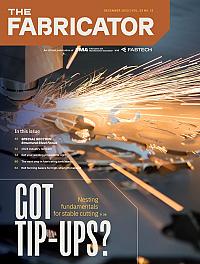Editor-in-Chief
- FMA
- The Fabricator
- FABTECH
- Canadian Metalworking
Categories
- Additive Manufacturing
- Aluminum Welding
- Arc Welding
- Assembly and Joining
- Automation and Robotics
- Bending and Forming
- Consumables
- Cutting and Weld Prep
- Electric Vehicles
- En Español
- Finishing
- Hydroforming
- Laser Cutting
- Laser Welding
- Machining
- Manufacturing Software
- Materials Handling
- Metals/Materials
- Oxyfuel Cutting
- Plasma Cutting
- Power Tools
- Punching and Other Holemaking
- Roll Forming
- Safety
- Sawing
- Shearing
- Shop Management
- Testing and Measuring
- Tube and Pipe Fabrication
- Tube and Pipe Production
- Waterjet Cutting
Industry Directory
Webcasts
Podcasts
FAB 40
Advertise
Subscribe
Account Login
Search
Smart fabricating of pressure tank vessel heads
New plasma nozzle hole-cutting technology elevates Brighton Tru-Edge’s product offerings
- By Dan Davis
- December 15, 2023
- Article
- Plasma Cutting
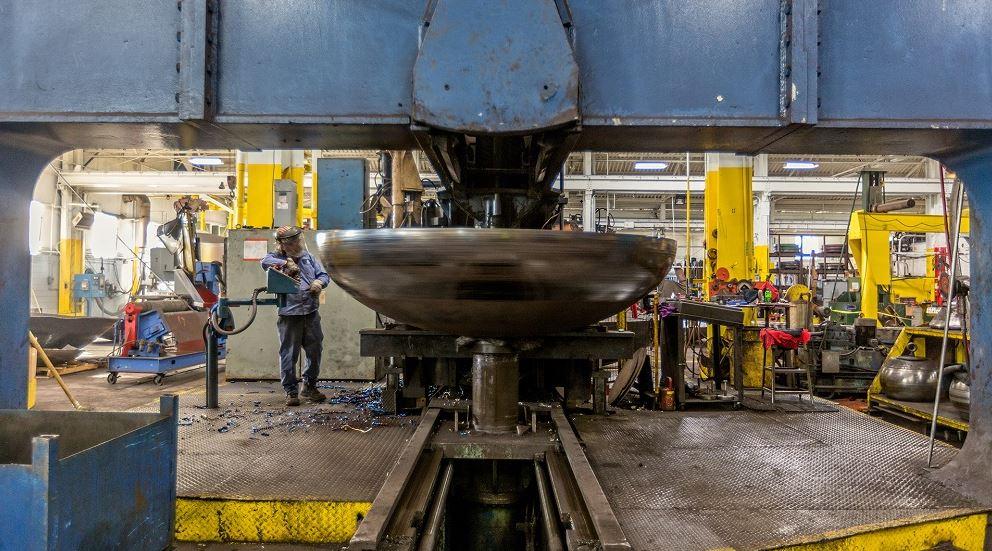
The tank head forming process takes place under the watchful eye of a skilled machine operator. Images: Bright Tru-Edge
Brighton Tru-Edge, which has been in operation for more than 100 years, has a history of challenging the way business is done.
Company Founder Alvin Hock set that tone when he first started as a coppersmith, making large kettles for many of the confectionary companies around Cincinnati and ultimately forged his way into the fabricating of pressure tank vessel heads. Now, under the leadership of Alvin’s grandson Adam, Brighton looks to shake up the sector with its new Tru-Cut 3D precision nozzle hole-cutting technology.
A Century of Craftsmanship
During the early years of the business, Brighton, as it was then known, focused on the manual fabrication of the kettles. No welding was involved. These fabrications were all hand-formed.
Eventually, the company got into pressure vessel fabrication as well, and Hock noticed that metal service centers owned most of the tank head fabricating equipment. These metal distributors viewed the tank heads as an enticement for metal fabricators and manufacturers to order material from them. Buy the plate for a pressure vessel application, and the service center could provide the tank heads as well.
Well, Hock decided to purchase some of his own head forming presses because he didn’t like being at the mercy of his metal distributors. He also figured others might have felt the same way.
Timing is a big part of success in the business world, and Hock’s actions were rewarded. Around that same time, metal service centers began to back away from head forming, realizing they weren’t making that much money on the activity. As a result, Hock stepped forward to take some of that fabrication equipment off their hands.
Those actions provided the foundation that has allowed the company, now known as Brighton Tru-Edge, to become the largest cold form tank head manufacturer in North America today, serving 800 different customers per year. It’s still in the Cincinnati area with two facilities, one of which is a 200,000-sq.-ft. shop dedicated to head forming, and the other is a fabricating operation in Natchez, Miss.
Brighton Tru-Edge has taken steps to shake up the tank head forming industry once again. In June, it installed new plasma nozzle cutting technology called the Tru-Cut 3D, which has the potential of drastically altering the amount of time needed to fabricate tank heads, while also eliminating costly mistakes.
Background on Head Forming
Before diving into the new cutting capabilities, however, it might be helpful to learn more about how Brighton Tru-Edge craftsmen create the tank head forms. To do that, you need to understand the difference between hot and cold forming heads.
In hot forming, a circular metal blank is placed on a die in a press. The ram drives the tooling into the metal and ultimately into the die on which it sits. The tank head is formed in one stroke.
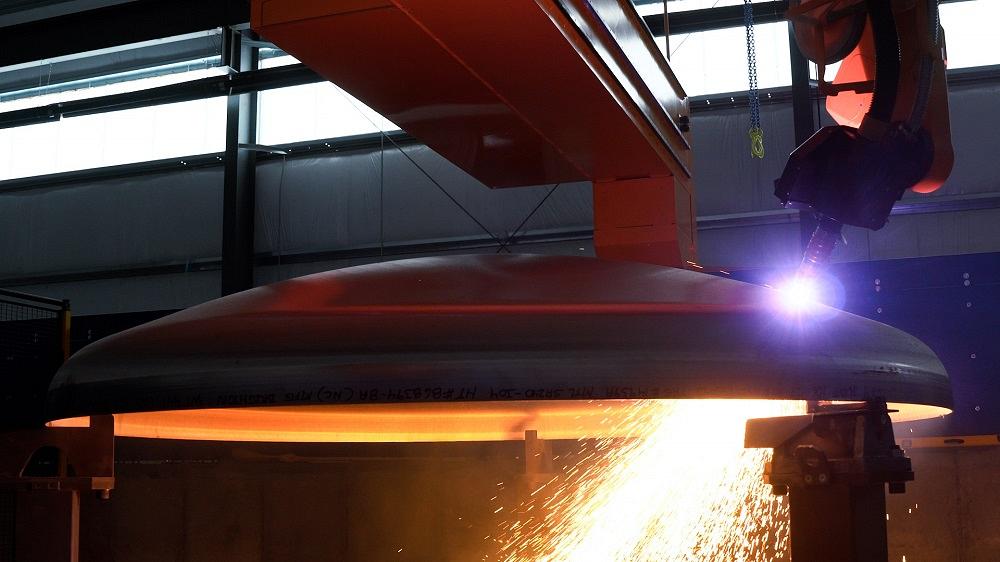
The Tru-Cut 3D precision nozzle hole-cutting technology from Brighton Tru-Edge is expected to save its tank and vessel fabricating customers hours.
Unfortunately, the world of vessel manufacturing isn’t consistent.
“What’s tough is that you can’t have a die set for every imaginable size out there,” Hock said.
Cold forming can address the variability that exists in tank head fabricating. It starts with a circular flat blank that’s placed in a press, but not of the stamping kind. This press uses a large tool with a radius end to form the tank head. Brighton Tru-Edge has 14 of these cold forming presses, the largest of which is 800 tons. These presses form the tank heads out of material typically ranging in thickness from 0.1875 to 1.75 in.
Cold forming is not a fast process, but it can deliver a custom head form without the need and expense of building tooling. Hock said that the equipment automates the forming to a point, but you still need the eye of an experienced machine operator to get it into the desired shape.
He added that an experienced operator can get a head form within 0.125 in. of specifications. Hock estimated that it can take as long as six months to two years to get an operator trained to the point where they can produce head forms to customer specs independently.
“All of our machines rely on a skilled craftsperson. They are all extremely talented,” Hock said. “It’s not like you would see in a CNC shop, where you put a billet into a machine, hit start, pull the part out, and then place it on a cart. Our operators are eyeballing the workpiece, pulling a tape measure out to get it just right, and making adjustments during the forming process because they know some materials move faster or slower than other types.”
From there, the formed workpieces go to flangers, which provide a good idea as to the purpose of the machine. Brighton Tru-Edge has 14 of these machines.
If the end customer is worried about work hardening of the metal during the forming, Brighton Tru-Edge offers solution annealing and quenching to get the material properties closer to what they were before fabrication began.
“We definitely have competitors in the U.S., but we really pride ourselves on a high-end product—using special alloys, aluminum, and titanium zirconium, for example,” Hock said.
He estimated that about 60% of the company’s tank head forming activities revolve around metals other than carbon steel, which roughly accounts for the other 40%.
“What’s unique about Brighton is that we have a passivation process,” Hock said. “All of our white metals that run through our shop go into an acid bath, and they come out free of any iron contamination. So our customers are getting a product that can sit outside, and it’s not going to rust.”
Making the Most of Fabricating Talent
Finding and retaining workers is a constant and widespread challenge for metal fabricating companies throughout the U.S. It’s even more of a challenge as companies have had to learn to deal with the expectations of Generation Z, who aren’t necessarily in love with the idea of doing the same job each day for the next five years. They also generally aren’t enamored with the idea of working overtime.
With that in mind, companies have to make the most of their current roster of employees. They need to be contributing to high-value activities that provide enough margins that a business can remain profitable.
Hock said that was the motivation behind the nozzle cutting process. This advanced plasma cutting technology was going to offer its fabricating customers a chance to offload a very tedious and time-consuming activity and free up its employees to take on other tasks.
“What’s the most skilled activity that’s required by a vessel fabricator? It’s laying those nozzle penetrations out on the head,” Hock said.
The Tru-Cut 3D technology is able to deliver exact cut results on a tank head despite variations from head to head. With the use of a laser scanner attached to the plasma cutting torch, the equipment is able to obtain a 3D rendering of the workpiece, compare it to the original 3D CAD drawing, and then adjust the production cutting sequence to deliver expected plasma-cut results even with a workpiece that might not be an exact replica of what the 3D model detailed.
Hock said that the 7-axis plasma cutting capabilities deliver holes cut with “absolute precision” and bevels that look like a laser cutting machine might have done them. The equipment uses a 440-amp Kjellberg Cutting plasma power source. It is rated to pierce steel up to 2 in. and cut up to 4.75 in.
“When these heads get delivered, they have beautiful bevels, and our customers can just start dropping nozzles and start welding as soon as the heads hit the shop floor,” Hock said.
He estimated that he is saving some vessel fabricators weeks’ worth of labor time with these precut holes in the tank heads. For instance, he said that the prep work required to cut holes in a tank head and then cut and prep the holes to receive connections could last up to a week, depending on the amount of work needed. The Tru-Cut 3D eliminates all of that and helps to reduce the potential for mistakes and the need for rework.
To provide a better idea of the effort involved to accomplish the task of cutting holes in a tank head, Hock described the process:
“A tank head is loaded off the truck, flipped over, laid on the floor, and shims are put underneath it so that it can be leveled. We shoot it with a laser to make sure it’s squared on the floor.
“After it’s leveled properly, we look at the customer drawing that shows where the nozzles actually are planned for the head. We pull a tape measure around the head, mark the quarter points of it, and put a mark in the center of the head.
“We see that we need to pull a nozzle at around 4 in. on the outside diameter, which is the equivalent of two degrees. I put a mark at 4 in. on the circumference. I then go to the center point, which we found earlier by pulling strings across the head. I mark that center point. Then I have somebody hold the tape measure at the top where the top center is, and I have somebody hold the tape measure on where the bottom inch mark was. I take a piece of soapstone or a marker, and I then draw a line. Now I’ve got the degree of where that nozzle needs to sit.
“Next, someone holds a tape measure at the center mark of the head. We know the nozzle needs to be out 20 in. from the center radius. So as someone is holding that tape measure, another person drops a plumb bob down while someone else takes a center punch to figure out just where that plumb bob is hitting. Now we know where the center of where that nozzle needs to sit.
“So now you know where the circle for the nozzle needs to go on the formed head, but it’s not really a perfect circle. When you look down from the top, it looks like a perfect circle, but when you look at the shape that needs to be cut, it’s actually more of an ellipse.
“What you need to do next is take the nozzle, drop it down, take a piece of soapstone, make sure the nozzle is centered, and trace around the outside of the nozzle. Then you take out the center punch and punch out where that soapstone was, so the circle doesn’t go away.
“You grab the plasma cutter or oxyacetylene torch, put the hood and protective gear on, blow through the material, and cut out the hole. You then try to bevel the cut edges to what are on the engineering drawings.”
That activity was just for one nozzle. All of that takes a couple of hours in the most skilled hands.
Needless to say, Brighton Tru-Edge knows what they can offer customers now with the Tru-Cut 3D technology. If the holes are placed exactly where they need to be on the tank head and the bevels match drawing specifications, customers can drop the nozzles into the head form and start welding almost immediately after receiving delivery of the workpieces.
“Think about all of the efficiency gains because all of these holes are precut,” said James Ferguson, chief marketing officer, HBH Holdings Inc., the parent company of Brighton Tru-Edge. “This allows the customer to focus its labor on the most important projects, such as welding. This saves them time and ultimately money.”
The Continuing Evolution
Coming off a strong 2023 where the company experienced robust growth, Hock said he expects Brighton Tru-Edge to enjoy another strong year in 2024. Growth will come with the current customer base and perhaps new ones as word gets out about its new cutting capabilities for tank heads. But the real promise for growth is around the corner because the industry will take its time acknowledging the new technology.
“Nobody’s ever sold anything like this domestically. People are used to making their own cuts, doing their own cleaning, and winding up with holes that weren’t consistent,” he said. “So it’s going to take a little time for the market to adopt that.”
Additionally, the plasma cutting technology won’t be the exclusive domain for Brighton Tru-Edge forever. But Hock said that doesn’t bother him. The company is actively conducting its own R&D, and it’s looking at the next logical step in helping out its fabricating customers—automated welding.
A brief walk around FABTECH’s welding pavilion in September provided metal fabricators an idea of what advanced vision technologies could possibly offer any automated welding equipment. While it’s not fully fleshed out now, that technology is not too far down the road. When it’s ready for commercialization, Hock said his company will be ready to lead the market in offering it to customers.
The search for skilled labor, particularly welders, to fill job vacancies is a universal pain point for metal fabricators. Brighton Tru-Edge believes it’s going to be in a good position to help its customers fill that gaping hole.
About the Author

Dan Davis
2135 Point Blvd.
Elgin, IL 60123
815-227-8281
Dan Davis is editor-in-chief of The Fabricator, the industry's most widely circulated metal fabricating magazine, and its sister publications, The Tube & Pipe Journal and The Welder. He has been with the publications since April 2002.
subscribe now

The Fabricator is North America's leading magazine for the metal forming and fabricating industry. The magazine delivers the news, technical articles, and case histories that enable fabricators to do their jobs more efficiently. The Fabricator has served the industry since 1970.
start your free subscription- Stay connected from anywhere

Easily access valuable industry resources now with full access to the digital edition of The Fabricator.

Easily access valuable industry resources now with full access to the digital edition of The Welder.

Easily access valuable industry resources now with full access to the digital edition of The Tube and Pipe Journal.
- Podcasting
- Podcast:
- The Fabricator Podcast
- Published:
- 04/16/2024
- Running Time:
- 63:29
In this episode of The Fabricator Podcast, Caleb Chamberlain, co-founder and CEO of OSH Cut, discusses his company’s...
- Trending Articles
Tips for creating sheet metal tubes with perforations

Are two heads better than one in fiber laser cutting?

Supporting the metal fabricating industry through FMA

JM Steel triples capacity for solar energy projects at Pennsylvania facility

Omco Solar opens second Alabama manufacturing facility

- Industry Events
16th Annual Safety Conference
- April 30 - May 1, 2024
- Elgin,
Pipe and Tube Conference
- May 21 - 22, 2024
- Omaha, NE
World-Class Roll Forming Workshop
- June 5 - 6, 2024
- Louisville, KY
Advanced Laser Application Workshop
- June 25 - 27, 2024
- Novi, MI
























